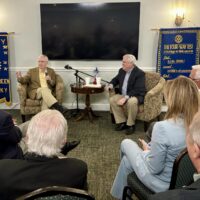Nothing says mistletoe and candy canes like the postcard-perfect small towns that populate American holiday movies. The best small town in the best Christmas movie ever (in my opinion, of course) is Bedford Falls, the fictional city located somewhere in western New York. Bedford Falls is the centerpiece of Frank Capra’s 1947 movie “It’s a Wonderful Life.”
Unlike the stereotypically rural villages that prop up cable-TV movies this time of year, Bedford Falls is complicated. There’s a bustling downtown, perhaps a bit on the large side for a small town. There are plenty of sidewalks and department stores. There’s a bus line, a taxi company, a train station, and even an airport.
But there’s also poor housing stock, a tough economy, limited investment capital, and brain drain – even if the high school does have a swimming pool under the gym floor.
Bedford Falls lies in an ambiguous space. It’s somewhere between Elmira (where the bank examiner wants to spend Christmas with his family) and Buffalo (where Harry has a job in research at his father-in-law’s glass factor).
It’s somewhere between the mountains (“Why, it’s 10 miles up to Mount Bedford”) and Manhattan (where a woman like Violet can get a new start).
But just where, exactly? Or, more importantly, just how rural?
The Facts of a Fictional Town
In my annual viewing of “It’s a Wonderful Life” this year, I took a few notes to see whether I could answer that question. It’s fun to consider this without population figures and commuting-zone maps. Freed from the handcuffs of hard data, I tapped narrative clues to determine Bedford Falls’ rural status. It’s a delight to use a DVD player instead of a spreadsheet to come up with an answer.
So what can we tell about the “ruralness” of Bedford Falls?
First, there’s the setting. Bedford Falls isn’t close to another town of similar size, and it’s definitely not near any larger city. There’s no talk of running over to another municipality just for diversion, the way Andy and Barney speak about going from Mayberry over to Mount Pilot just for a change of pace.
The closest thing to a road trip seems to be a quick drive out to Martini’s roadhouse for a drink. But even there, small-town constraints come along for the ride. “Why you drink so much, my friend?” Martini asks our hero, George Bailey. “Please go home, Mr. Bailey.”
Sometimes you don’t want to go where everybody knows your name.
A little more evidence comes in hints that the outskirts of Bedford Falls are not developed. There are fields — the ones Violet refuses to walk barefoot in. And there are wildlands like Mount Bedford, where you can “smell the pines and watch the sunrise against the peaks.”
A Lack of “Homecomers”
Another small-town concern of Bedford Falls is the loss of young people, especially the college-educated crowd. Sam Wainwright, old “Hee Haw,” leaves to make his fortune in plastics. George’s brother, Harry, finds opportunity in research in Buffalo after attending college.
The single “homecomer” in the bunch is Mary, George’s wife-to-be, who returns to Bedford Falls after college for what today we’d call “quality-of-life” considerations – closeness to extended family, the chance to raise a family, and a great price on a fixer-upper, the decrepit Granville house.
But the biggest clue about Bedford Falls’ relatively remote status is the economic market. The town’s economy is small enough that one man, the evil Mr. Potter, can run the show. He’s cornered the market from one end of Main Street to the other.
“He’s already got charge of the bank,” George says when there is a run on the Bailey Bros. Building and Loan Association. “He’s got the bus line. He’s got the department stores. And now he’s after us.”
The “us” is the building and loan association, the only institution standing in the way of Potter’s thumb and the entirety of Bedford Falls.
“This town needs this measly one-horse institution if only to have someplace where people can come without crawling to Potter,” George says in a speech to the association’s board of directors.
But just as one bad person can make a big difference in a small town, so too can one good person. And that’s the premise of “It’s a Wonderful Life.” One person can change everything, as George learns in miraculous fashion on Christmas Eve.
The Limits of Individualism
The power of the individual is a theme in Capra’s movies. Bedford Falls is the perfect setting for his philosophy: one pure-hearted underdog can overcome the forces of evil.
Before “It’s a Wonderful Life” found a second life on cable TV in the 1980s and ’90s, Capra’s best known film was “Mr. Smith Goes to Washington.” In that 1939 film, Jefferson Smith (again played by Stewart) takes on an evil-hearted senator and all of Capitol Hill.
The hero’s victory is far more believable in Bedford Falls than it is in Washington, D.C., in my opinion. The human scale of small towns makes it possible for one person to take on a cause and win.
But here I’m succumbing to a rural stereotype — namely that rural places thrive or fail solely on their own merits. The reality is that few rural problems stop at the city limits or the county line. There’s a pattern of national policy and corporate behavior that plays a big role, too. The Mr. Potters of the world are organized. The George Baileys better be, too.
The Bottom Line
So where does this leave us?
Bedford Falls is a town of some substance, based just on infrastructure and the size of its business district and residential development. But it’s far from the next town or city, functions primarily on personal relationships, has trouble retaining its young people, and has individuals who play an outsized role in its economic success.
That puts Bedford Falls mostly in the rural category for me.
If you feel differently, you might convince me otherwise over a cup of hot chocolate or eggnog. I’m not likely to change my mind, but miracles do happen.
Tim Marema is editor of the Daily Yonder.






